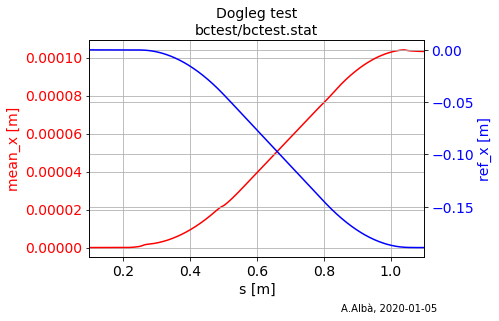opal AT lists.psi.ch
Subject: The OPAL Discussion Forum
List archive
- From: Philippe Piot <piot AT nicadd.niu.edu>
- To: Arnau Albà <arnau.alba AT hotmail.com>
- Cc: Philippe Piot <piot AT nicadd.niu.edu>, opal AT lists.psi.ch
- Subject: Re: [Opal] Ks and Ksc frame
- Date: Mon, 6 Jan 2020 06:07:17 -0600
Dear Arnau,
Thank you for the clarification. So rotation that is applied to the z-axis when transforming Ks->Ksc essentially only occurs downstream of deflecting elements (i.e. elements that can change pz -- e.g. dipole or deflecting cavity). However, I use a deflecting cavity at zero crossings (so that the head and tail are deflected in opposite directions) the mean momentum of the bunch remains unchanged, yet a large t-x correlation generally develops. So in order to make sure I properly resolve this bunch (for space charge calculation) I should increase the number of grid cells in x and z (since, due to the correlation, many grid cells will be empty if the Ksc is not rotated according to the spatial correlations). Is my understanding correct? I assume the choice to rotate according to the mean z momentum is due to the option of doing energy binning for the Lorentz transformations?
Thanks again. All the best, -- Philippe.
Philippe Piot,
https://www.niu.edu/advanced-accelerator-randd/
Northern Illinois University, Dept of Physics and
Northern Illinois Center for Accelerator & Detector Development
DeKalb, IL 60115, USA
Tel: 815 753 6473, Web: http://www.physics.niu.edu/physics/
Argonne National Laboratory, Advanced Photon Source
Accelerator System Division
https://www.niu.edu/advanced-accelerator-randd/
Northern Illinois University, Dept of Physics and
Northern Illinois Center for Accelerator & Detector Development
DeKalb, IL 60115, USA
Tel: 815 753 6473, Web: http://www.physics.niu.edu/physics/
Argonne National Laboratory, Advanced Photon Source
Accelerator System Division
Lemont, IL 60439, USA
Tel: 630 252 2415, Web: https://www.aps.anl.gov/Accelerator-Systems-Division On Sun, Jan 5, 2020 at 11:01 PM Arnau Albà <arnau.alba AT hotmail.com> wrote:
Hi Philippe,I will answer to the best of my knowledge.Ks is a coordinate system attached to the reference particle (a.k.a. design particle), with its z-axis in the same direction as the momentum of the reference particle.The bunch will follow a trajectory similar to the design trajectory, but not exactly the same. That is why there is another coordinate system Ksc, which is at the center of the bunch and whose z-axis is aligned with the mean momentum of the bunch.At each time-step OPAL pushes both the reference particle and the particles in the bunch, so both Ks and Ksc are updated at each time-step.The rotation that is applied to the z-axis when transforming Ks->Ksc is the same rotation that is applied to the x and y axes. So the x and y axes are not specifically aligned according to the correlations in the bunch.Regarding your plots from the dogleg example:You can find what each output from the stat file means in the documentation https://gitlab.psi.ch/OPAL/Manual-2.2/wikis/opalt#sec.opalt.opalt-outputIn your case you are plotting mean_x, which is the bunch mean position relative to the reference particle (i.e. in the Ks coordinate system), and that is the reason for those kinks that you observe at each dipole. If you want to see the trajectory of a particle through the dogleg in the lab coordinate system, you could for example plot ref_x.I hope that answers your questions.Best regards,Arnau AlbàOn Fri, 3 Jan 2020 at 12:24, Philippe Piot <piot AT nicadd.niu.edu> wrote:Dear All,I would like to clarify how the Ksc is found (sorry these may be very naive questions).1/ I do not understand the statement in the user manual Sec "... coincides with the mean position of the particles and the mean momentum is parallel to z". I understand Ksc origin coincides with the bunch center but I would expect a statement on the basis vectors orientation. I take it from the statement that Ksc is generally aligned with (x,y,z) if the beam is moving rectilinearly?2/ In fact, and in general, it appears from Fig. 6.2 that Ksc is rotated so that its "longitudinal" basis vector aligns with the local tangent of the reference trajectory? Though I do not get why Ksc is not exactly on Ks as the flow diagram of sec. 6.6 seems to imply.Finally what happened in the case of a beam with a strong spatial correlation between two degrees of freedom? For instance, I have a flat beam with a strong correlation in (x,y) is the Ksc frame rotated accordingly to ensure the cartesian space-charge grid is optimally matched to the principal axis of the beam?Thank you very much. All the best, -- Philippe.Philippe Piot,
https://www.niu.edu/advanced-accelerator-randd/
Northern Illinois University, Dept of Physics and
Northern Illinois Center for Accelerator & Detector Development
DeKalb, IL 60115, USA
Tel: 815 753 6473, Web: http://www.physics.niu.edu/physics/
Argonne National Laboratory, Advanced Photon Source
Accelerator System DivisionLemont, IL 60439, USATel: 630 252 2415, Web: https://www.aps.anl.gov/Accelerator-Systems-Division
- [Opal] Ks and Ksc frame, Philippe Piot, 01/03/2020
- Re: [Opal] Ks and Ksc frame, Arnau Albà, 01/06/2020
- Re: [Opal] Ks and Ksc frame, Philippe Piot, 01/06/2020
- Re: [Opal] Ks and Ksc frame, Arnau Albà, 01/06/2020
- Re: [Opal] Ks and Ksc frame, Christof Metzger-Kraus, 01/09/2020
- Re: [Opal] Ks and Ksc frame, Arnau Albà, 01/06/2020
- Re: [Opal] Ks and Ksc frame, Philippe Piot, 01/06/2020
- Re: [Opal] Ks and Ksc frame, Arnau Albà, 01/06/2020
Archive powered by MHonArc 2.6.19.
